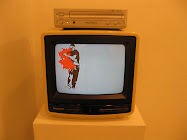So cigarettes are totally anathema these days. I walked into the Menil's lobby, packed with black chairs, only a few minutes late for Bernice Rose's lecture last night. Slipping in the door and down the right aisle, I sat down as quietly as possible while Rose pontificated on her first slide.
The lady next to me froze. She turned away. She ducked down. She made awkward hand gestures for a minute and finally shoved by me to sit elsewhere in the room. Jeez. I knew having a drag on the drive over would make me smell like cigarettes, and buying Camel Wides because they were on sale sure exacerbated the situation, but causing a scene was not on my agenda. At least there wasn't a mass exodus from around me. That would've looked really fucking bad. I'm quitting anyway. I don't want to, but it is out of bounds at this point to enjoy a smoke anywhere other than in polite company. I'll quit on International Workers Day.


The Menil Collection's New Drawing Institute and Study Center launched with their recent How Artists Draw show, and their new director Bernice Rose demonstrated her "kitchen sink" approach to the Drawing Institute in both her speech and her curatorial style.
Ms. Rose's lecture (with asides by Menil director Josef Helfenstein) was packed with close readings and revelatory interpretations of Picasso, Duchamp and Max Ernst, but her delivery wound circles around her subjects with frequent pit stops across a spectrum of cul-de-sacs. The tightly packed galleries gave Rose ample opportunity to leisurely pontificate on the established significance of each and every collection- continually driving home the point that this was to be "An Institute based around concentrated collections by established artists that does not seek to be comprehensive, but illuminate the movements of the 20th century," [paraphrased, but she said it enough times- I do not believe that would be contested]
Helfenstein didn't seem to say much, but it was encouraging to hear him bring up the importance of locale in a collection's focus- a large drawing collection is reason for scholars to travel and study, but the geography of an institution is important in realizing the focus of a collection. Granted, he was talking up Robert Rauschenberg (from Port Arthur) but it did seem to leave the door open for some attention paid to Gulf Coast artists or younger Houston artists.
Wouldn't that be cool if a little money and time went into snagging a few drawings on the cheap and having a bit of the contemporary local in there wit' the big boys?
Anyway, Bernice Rose is ridiculously versed in her subjects. Her delivery was a little jumbled, though; as the stories and anecdotes outweighed the forward progress (in Powerpoint and presentation) my ass started to hurt in those uncomfortable modernist chairs. Helfenstein totally phoned it in, dude.
When the lights went up I felt compelled to follow the herd bolting for the doors. Bernice gave me a look like I was skipping class, but I really couldn't sit there any longer without breaking my tailbone. There were maybe ten people not waiting for the Q & A; I didn't realize until I reached the car that everyone I followed out of the building was 18-25. I guess they were feeling a little uncomfortable in their chairs too.

How Artists Draw is a painful show filled with amazing work. The earliest pieces in the show are nearly shoved out the door by the burgeoning galleries behind them. I had no choice but to just glance at the Van Gogh, the Seurat and a few amazing sketches from the 1800s and keep moving until the third time I went.
Pick your poison; left to Dada and collages that rival Joy Division and The Replacements for making pleasure out of pain. Right to a suite of Picassos that'll have you stuffed with fat and flavor like a Reuben from Spec's. I was totally pissed that DeBuffet had short shrift on another wall, but they had to jump on to...
Americans! Once again the show is more like Choose Your Own Adventure than a consciously thought out exhibit. Left to Rothko and a bunch of boring little sketches, unless you appreciate that these pathetic blobs were the germ of so many hallucinatory and spiritual canvasses. Two dour easter egg-style paintings by Mark Rothko hang in a cove, powerful despite their lack of transcendental weight. Or... right to Pollock and deKooning, providing an imagist alternative to the other 50s gallery. The first of three late Pollocks is so bright and solid it looks like Nancy Graves, the other two contextualize such solid lines of color with splatter painting and the dyed black brushstrokes usually associated with Pollock as he drank his way to oblivion. The triple odd couple is capped off by a "sketch" where Pollock slapped a big white mess onto a Paris fashion plate.
There is a whole other half of the exhibit, but I won't tell you about it. It would take too long and it is a better representation of how I feel about five exhibits worth of work to cut this sh























0 comments:
Post a Comment